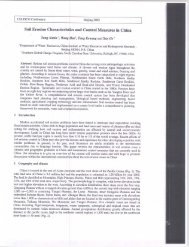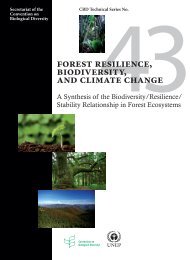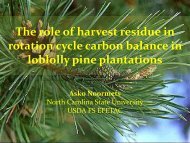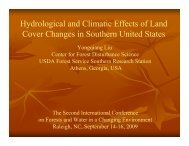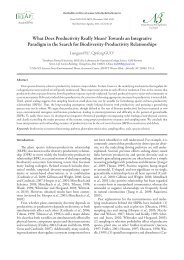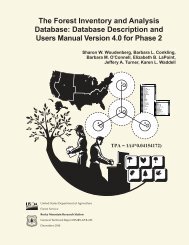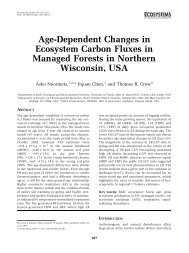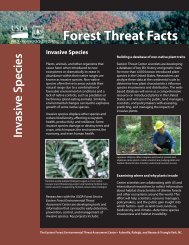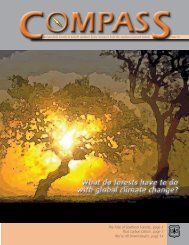CRAFT - Eastern Forest Environmental Threat Assessment Center
CRAFT - Eastern Forest Environmental Threat Assessment Center
CRAFT - Eastern Forest Environmental Threat Assessment Center
You also want an ePaper? Increase the reach of your titles
YUMPU automatically turns print PDFs into web optimized ePapers that Google loves.
For more information:<br />
Please visit http://www.craft.forestthreats.org<br />
to learn more about <strong>CRAFT</strong> or contact EFETAC<br />
or UNC Asheville’s NEMAC for additional<br />
information:<br />
<strong>Eastern</strong> <strong>Forest</strong> <strong>Environmental</strong> <strong>Threat</strong><br />
<strong>Assessment</strong> <strong>Center</strong><br />
Danny C. Lee, Director<br />
(828) 257-4854<br />
dclee@fs.fed.us<br />
http://www.forestthreats.org<br />
UNC Asheville’s National <strong>Environmental</strong><br />
Modeling and Analysis <strong>Center</strong><br />
Karin Lichtenstein, Project Manager/Research Scientist<br />
(828) 250-3892<br />
klichten@unca.edu<br />
http://orgs.unca.edu/nemac/<br />
Photographs courtesy of USDA <strong>Forest</strong> Service, Southern<br />
Region, Atlanta, GA<br />
The Comparative<br />
Risk <strong>Assessment</strong><br />
Framework and<br />
Tools (<strong>CRAFT</strong>)<br />
A structured,<br />
comprehensive approach<br />
to natural resources<br />
planning and analysis<br />
www.craft.forestthreats.org<br />
The U.S. Department of Agriculture (USDA) prohibits<br />
discrimination in all its programs and activities on the basis of<br />
race, color, national origin, age, disability, and where applicable,<br />
sex, marital status, familial status, parental status, religion,<br />
sexual orientation, genetic information, political beliefs, reprisal,<br />
or because all or part of an individual’s income is derived from<br />
any public assistance program. (Not all prohibited bases apply<br />
to all programs.) Persons with disabilities who require alternative<br />
means for communication of program information (Braille, large<br />
print, audiotape, etc.) should contact USDA’s TARGET <strong>Center</strong><br />
at (202) 720-2600 (voice and TDD). To file a complaint of<br />
discrimination, write to USDA, Director, Office of Civil Rights,<br />
1400 Independence Avenue, S.W., Washington, D.C. 20250-<br />
9410, or call (800) 795-3272 (voice) or (202) 720-6382 (TDD).<br />
USDA is an equal opportunity provider and employer.<br />
Southern Research Station<br />
U.S. <strong>Forest</strong> Service<br />
Science Update SRS-024<br />
<strong>Forest</strong>s are naturally complex and have become increasingly more difficult<br />
to manage due to existing and emerging environmental threats. As a result,<br />
forest management faces many obstacles, but none more challenging<br />
than an uncertain future. How will climate and land use change, disease,<br />
or invasive species impact forest health <strong>Forest</strong>s are in constant flux and<br />
competing demands, and consequent tradeoffs, for clean air and water,<br />
forest products, and recreation add further management challenges.<br />
U.S. Department of Agriculture, <strong>Forest</strong> Service<br />
Southern Research Station<br />
<strong>Eastern</strong> <strong>Forest</strong> <strong>Environmental</strong><br />
<strong>Threat</strong> <strong>Assessment</strong> <strong>Center</strong>
How Does <strong>CRAFT</strong> Work<br />
<strong>CRAFT</strong> emphasizes comparative risk assessment,<br />
empowering users to focus on measurable values,<br />
be more inclusive of tradeoffs, and understand<br />
associated uncertainties. <strong>CRAFT</strong> focuses on a threepart<br />
approach to help managers and groups make<br />
informed decisions:<br />
• Values – identification of diverse stakeholders and<br />
resource needs<br />
• Probabilities – consideration of likely effects and<br />
uncertainties<br />
• Tradeoffs – broadened understanding of conflicts<br />
The <strong>CRAFT</strong> Process<br />
<strong>CRAFT</strong> uses four primary stages to help users<br />
directly examine potential risks:<br />
• Specifying Objectives—What is the problem It<br />
is important to prioritize management objectives<br />
in order to anticipate possible conflicts and<br />
competing values. <strong>CRAFT</strong> can help organize<br />
management and stakeholder values using clear<br />
and effective techniques and exercises.<br />
• Designing Alternatives—What to do An<br />
ecosystem is complex, therefore different<br />
alternatives can have varying effects. <strong>CRAFT</strong><br />
helps design alternatives based on how well they<br />
might satisfy multiple objectives.<br />
• Modeling Effects—What could happen<br />
<strong>CRAFT</strong> links objectives, actions, and probable<br />
consequences using a tool called a belief<br />
network. It models complex environmental<br />
dynamics and displays the consequences and<br />
uncertainties of alternative actions.<br />
• Synthesis—What to communicate All<br />
information generated in previous steps is<br />
compiled, providing an enhanced understanding<br />
of the interplay among scenarios, uncertain<br />
outcomes, and diverse values.<br />
<strong>CRAFT</strong> uses imagery to model<br />
landscape variability.<br />
<strong>CRAFT</strong>ing Solutions for<br />
<strong>Forest</strong> Managers<br />
To help address these challenges, the USDA <strong>Forest</strong><br />
Service’s <strong>Eastern</strong> <strong>Forest</strong> <strong>Environmental</strong> <strong>Threat</strong><br />
<strong>Assessment</strong> <strong>Center</strong> (EFETAC) and the University of<br />
North Carolina Asheville’s National <strong>Environmental</strong><br />
Modeling and Analysis <strong>Center</strong> (NEMAC) designed<br />
a planning framework, called the Comparative Risk<br />
<strong>Assessment</strong> Framework and Tools (<strong>CRAFT</strong>). <strong>CRAFT</strong><br />
is a user-friendly, Web-based support system that<br />
builds on the National <strong>Environmental</strong> Policy Act<br />
(NEPA) framework for managing public lands and<br />
approaches forest issues comprehensively. The tool<br />
incorporates decision making techniques and guides<br />
managers and diverse stakeholders through<br />
• a structured approach for identifying and<br />
clarifying objectives;<br />
• a way to gain a feasible set of alternatives;<br />
• an ability to match real-life problems to existing<br />
models and tools;<br />
• a method of calculating the risks and tradeoffs<br />
associated with different management scenarios.<br />
Additional <strong>CRAFT</strong> Resources<br />
<strong>CRAFT</strong> features a wealth of online resources,<br />
including a tutorial and <strong>CRAFT</strong>iPedia—a “wiki”<br />
style reference database and glossary. For team<br />
projects, the <strong>CRAFT</strong> online tool can store and<br />
share diagrams, text, tables, data, and models<br />
created during the decision-making process.<br />
UNC Asheville’s NEMAC is available to provide<br />
assistance, team training, and group workshops.



